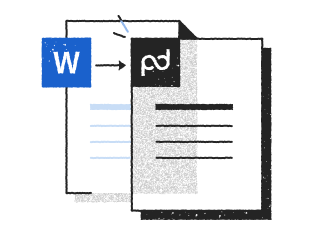How to create an electronic signature in Word
It’s no surprise that more and more people these days are seeking simple guidance on how to create an electronic signature in Word.
Fortunately, this is not as difficult as it may first appear. Here are the basic steps:
- Navigate to the Insert tab
- Under “Text,” click “Signature List”
- Click “Microsoft Office Signature Line“
- Complete the fields about signature details in the setup box that pops up
- Select your preferences for the signature box
- Simply right-click on the signature box in the document
- Click “Select Image” to choose an image of a signature that you have already saved
Congratulations! You’ve just created an electronic signature in Word.
Despite its popularity, Microsoft Word is quite limited concerning wider functionality when it comes to electronic signatures.
This makes Microsoft an outdated software choice for many organisations looking to create and add electronic signatures for free.
They would otherwise benefit by switching to more dedicated eSigning platforms, such as PandaDoc.
On the bright side, there’s still a lot that can be done with Microsoft Word. In this article, we’ll cover the following:
- What is an electronic signature?
- How is it useful to sign a document electronically?
- How to make an electronic signature leverage your business
- Why create an electronic signature in Microsoft Word?
- How to create an electronic signature for a Word document
- How to add an electronic signature to a Word document: a step-by-step guide
- Why switch from using Word for electronic signatures?
- How to do an electronic signature on alternative platforms to Word
- How PandaDoc integrated software can make creating electronic signatures even easier
Let’s make the electronic signature of your dreams!
What is an electronic signature?
An electronic signature, also known as an eSignature, is merely a digitised form of a traditional physical signature, making the document-signing process a fast-moving activity.
Like a standard handwritten signature, electronic signatures are mostly there to serve as proof that the signer has approved the document in question.
How is it useful to sign a document electronically?
Before we explore this subject further, it’s essential to know the what, why, and how of electronic signatures.
Since we’re already done with the “what,” it’s about time we discover the “why.”
For starters, eSignatures are a lot faster to use than traditional signatures, since you don’t have to print, physically sign, scan the document, and then have it sent back to the sender.
Another handy feature of eSignatures is that they only need to be created once, and then the copy signature can be added quickly and easily to any future document.
For anyone needing to send out signed documents frequently, eSignatures can significantly improve their workflow.
Teams like sales, admin, accounts, etc., as well as many business owners, can profoundly benefit from its use.
For the most part, an electronic signature is just as legally binding as a real signature (read: certain countries consider written signatures as taking higher precedence over eSignatures).
Oh, and before we forget: they are also encrypted — so rest assured, electronic signatures are safe to use even with critical and sensitive documents.
How to make an electronic signature leverage your business
If you are partnering with a brand, you ideally need an application that can do more than just create an electronic signature.
When looking at how to create an electronic signature, it is important that the software be a brand that understands the importance and benefits of using electronic signatures.
These eSignature benefits should include:
- Getting instant updates.
- Being able to deploy automation for signature tracking.
- Easy accessibility of signing different file types.
- Access to enhanced security.
PandaDoc has all these features and then some. You can scan, view, and sign a document, all at the same time, and easily.
If you’re interested in exploring further, send yourself a (free) sample copy to view the eSignature journey from the eyes of your customers.
Why create an electronic signature in Microsoft Word?
Microsoft Word is the universal word processing software used by businesses and individuals across the world to create documents.
As it is so widely used, many people choose to add eSignatures to documents in Word to increase the speed of their document processes. (It often might do otherwise, but more on that later.)
The main advantage of adding an electronic signature in Word documents is the very fact that most businesses already use the software to create and edit their documents.
However, while this may be the most obvious benefit, decide if your organisation can indeed support the use-case of electronic signatures before moving forward with a solution.
How to create an electronic signature for a Word document
Before you can add an electronic signature in Word, firstly you have to prepare one.
If you’re new to this, an electronic signature is created from a digital representation of your signature.
You can then easily add the electronic signature to digital documents. So, let’s look at how to prepare an electronic signature:
Choose a method
The first step is to decide on the method you want to use to create your electronic signature. There are various options:
- Digital stylus or pen: If you have a digital stylus or pen, you can use it to draw your signature directly on a touchscreen device. This method creates a more accurate and natural-looking signature.
- Mouse or touchpad: If you don’t have a stylus or touchscreen device, you can use your computer’s mouse or touchpad to draw your signature, but it may take a more practice to achieve a result that looks like your actual signature.
- Scanner and image editing software: You can also create an electronic signature by scanning a copy of your handwritten signature and saving it as an image file (e.g., PNG, JPEG).
You then have the option of using image editing software to refine the scanned signature.
Create a signature
Now it’s time to create your signature, using your chosen method.
If you’re drawing it digitally, take the time to make it as close to your handwritten signature as possible.
If you’re scanning a signature, always make sure it is neat and well-defined.
Save your signature
Save your signature as an image file (e.g., PNG, JPEG), if you’ve drawn your signature digitally.
Save it to a place on your computer where you can find it easily.
However, if you’ve scanned your signature, save the scanned image to your computer.
Refine your signature
Don’t worry if your digital signature doesn’t look quite right. You can always use image editing software to refine it.
Options such as adjusting the size, contrast, and sharpness of the signature can all help to make it look more professional.
Test your signature
A good piece of advice before using your electronic signature in important documents is to practice inserting your electronic signature into sample documents.
This gives you an opportunity to see how it looks and make any edits.
Secure your signature
Treat your electronic signature in the same way you would your handwritten signature.
Remember to keep your e-Signature secure and confidential to prevent unauthorized use, and always use a secure, password-protected folder or file to store it.
How to add an electronic signature to a Word document: a step-by-step guide
At this point you will be asking, “How do I write my signature on a Word document?”
Well, that’s the next step!
Follow this guide step-by-step to add a digital signature to a Word document (“word” of caution, no pun intended): these steps are only relevant on the Microsoft Word versions 2007, 2010, 2013, 2016, 2019, and Word in Office 365):
1. Place the cursor where you’d like to add a signature to a Word document.
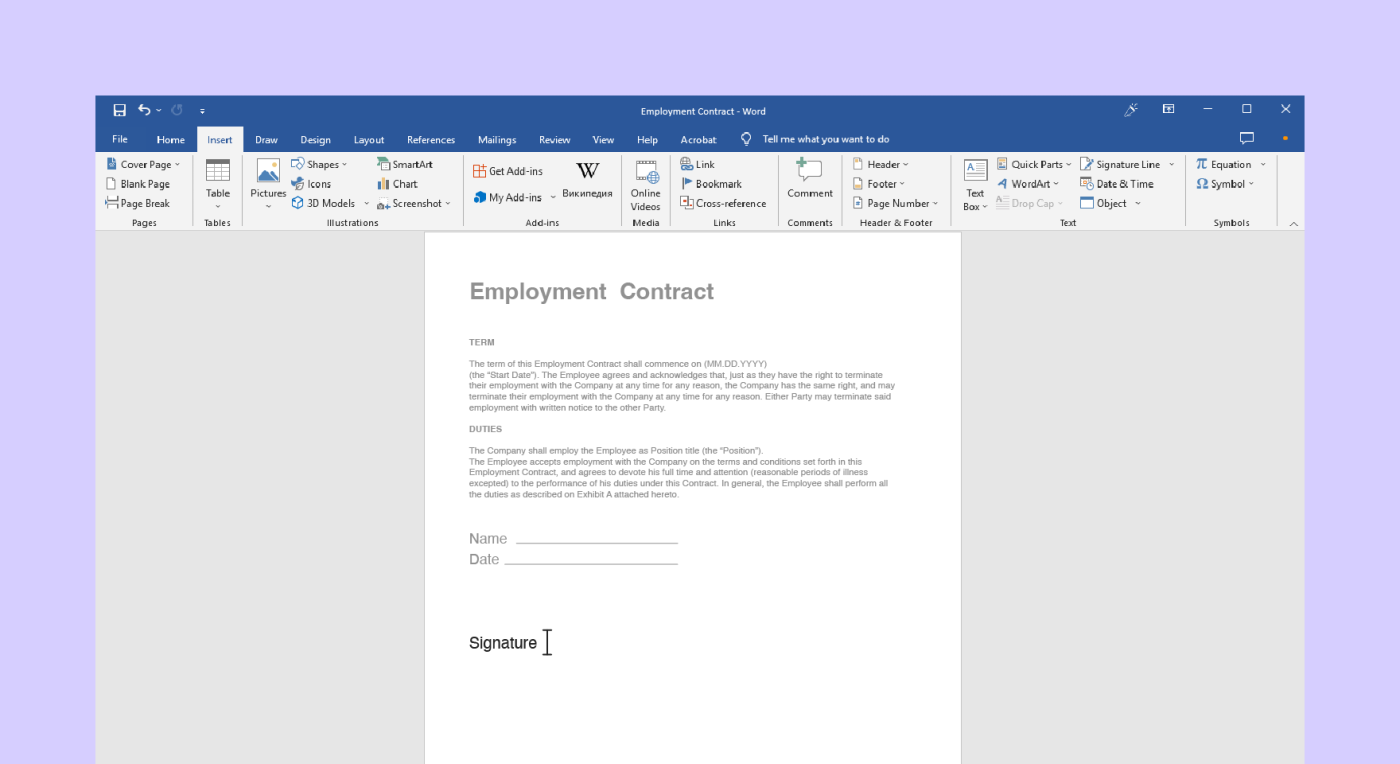
2. Go to the Insert tab, and under “Text,” click “Signature List,” followed by “Microsoft Office Signature Line“.
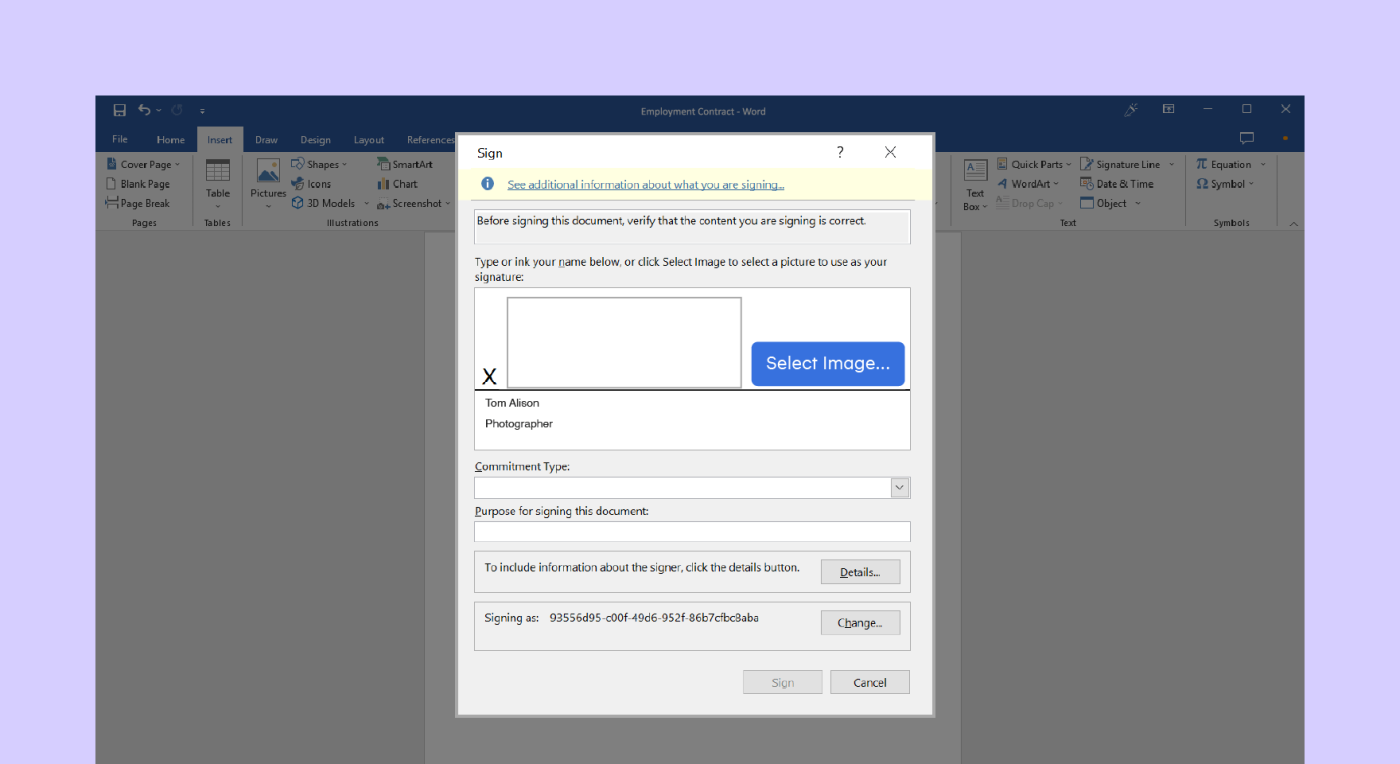
3. Complete the fields about signature details in the setup box that pops up and select your preferences for the signature box.
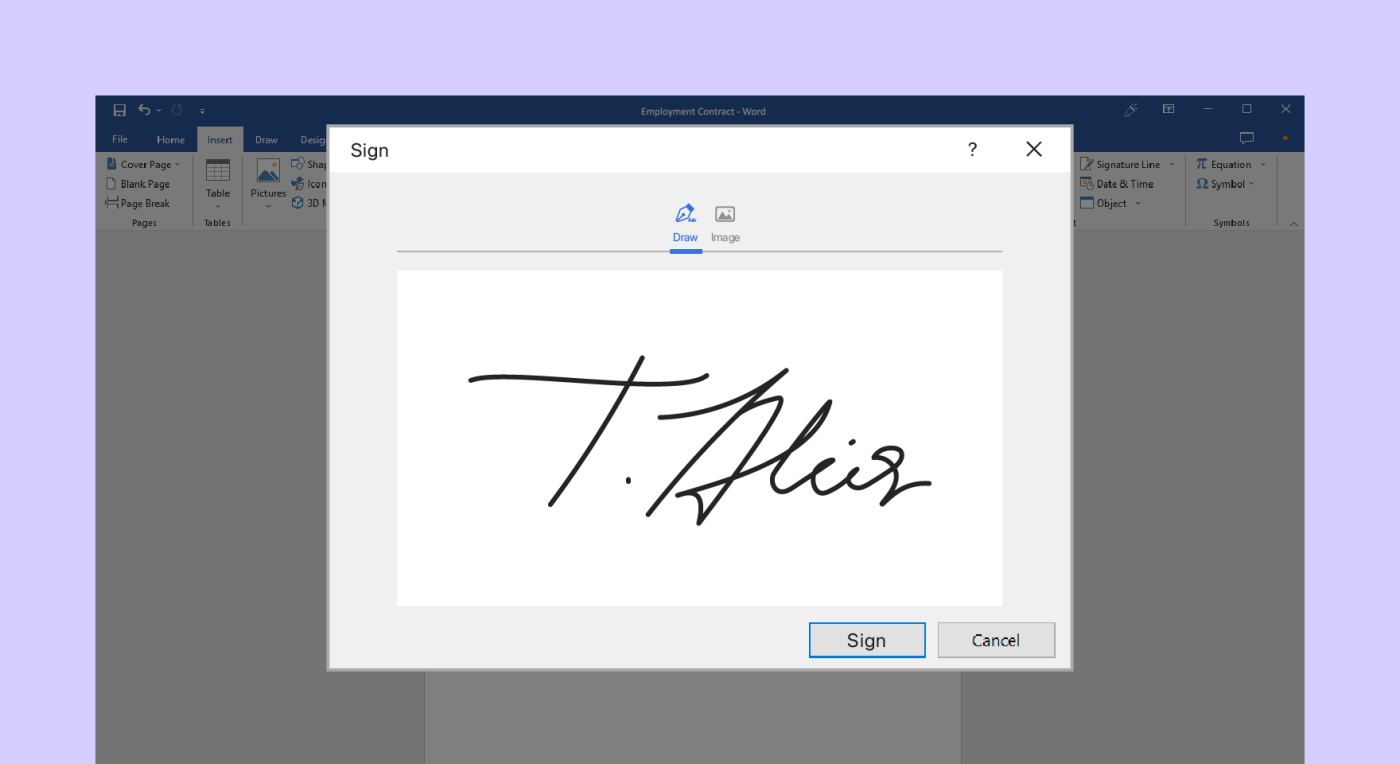
4. Right-click on the signature box in the document.
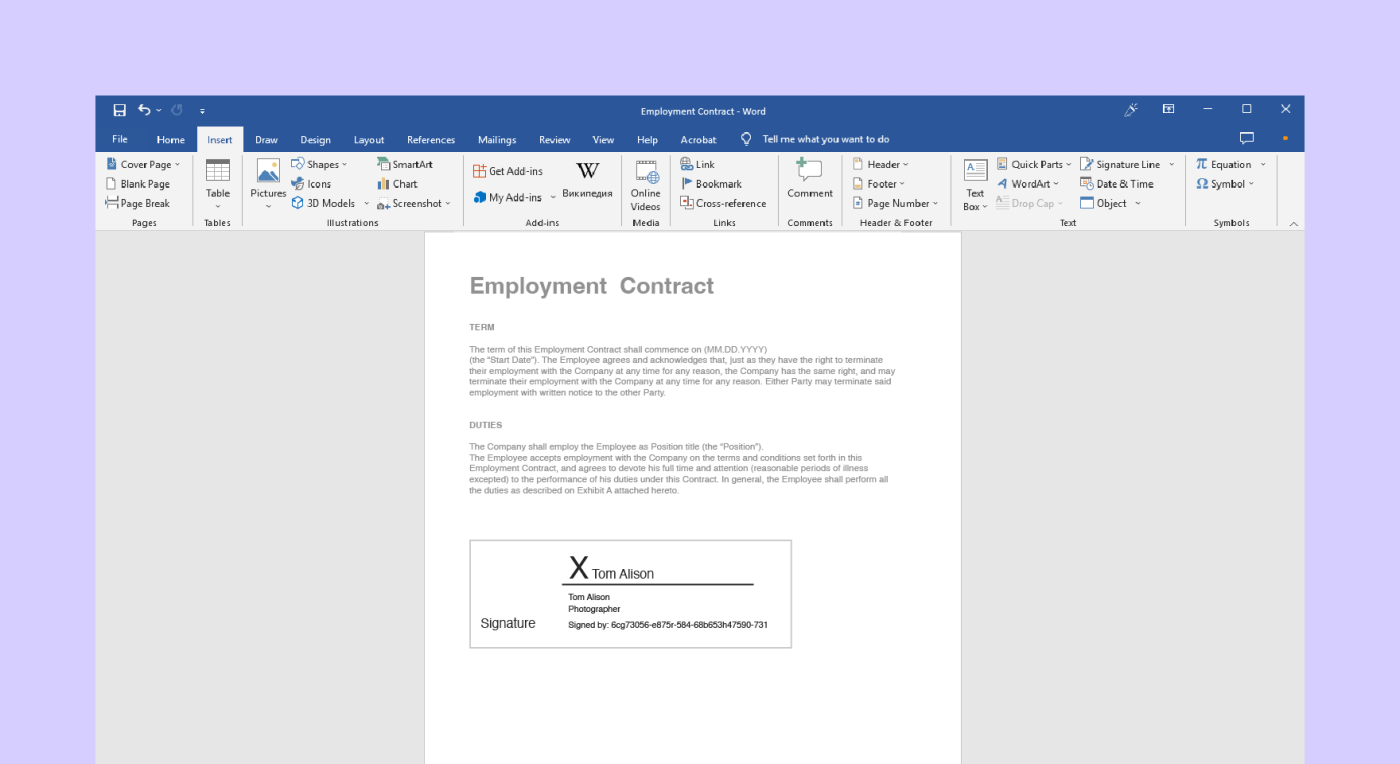
5. After this, click “Select Image” to choose an image of a signature that you have already saved.
Alternatively, if you’re using a touch screen, you can hand draw your signature into the box. You can also type a printed version of your name directly into the box.
While it’s entirely possible to eSign documents using Word, the signature setup can be a convoluted process.
Every person who’s signing the document will need to download the document, open it in Word, and follow step 4 to add their signature.
Note: If creating an electronic signature is not your thing, then you can print and hand-sign them as well. However with this method, you’ll need to save the document and send it back to the sender, which only wastes time and potentially opens up room for human error.
How to add a signature line in the Word doc
1. Place your cursor where you would like to add the signature line.
2. Go to the “Insert” tab, and select “Signature line.”
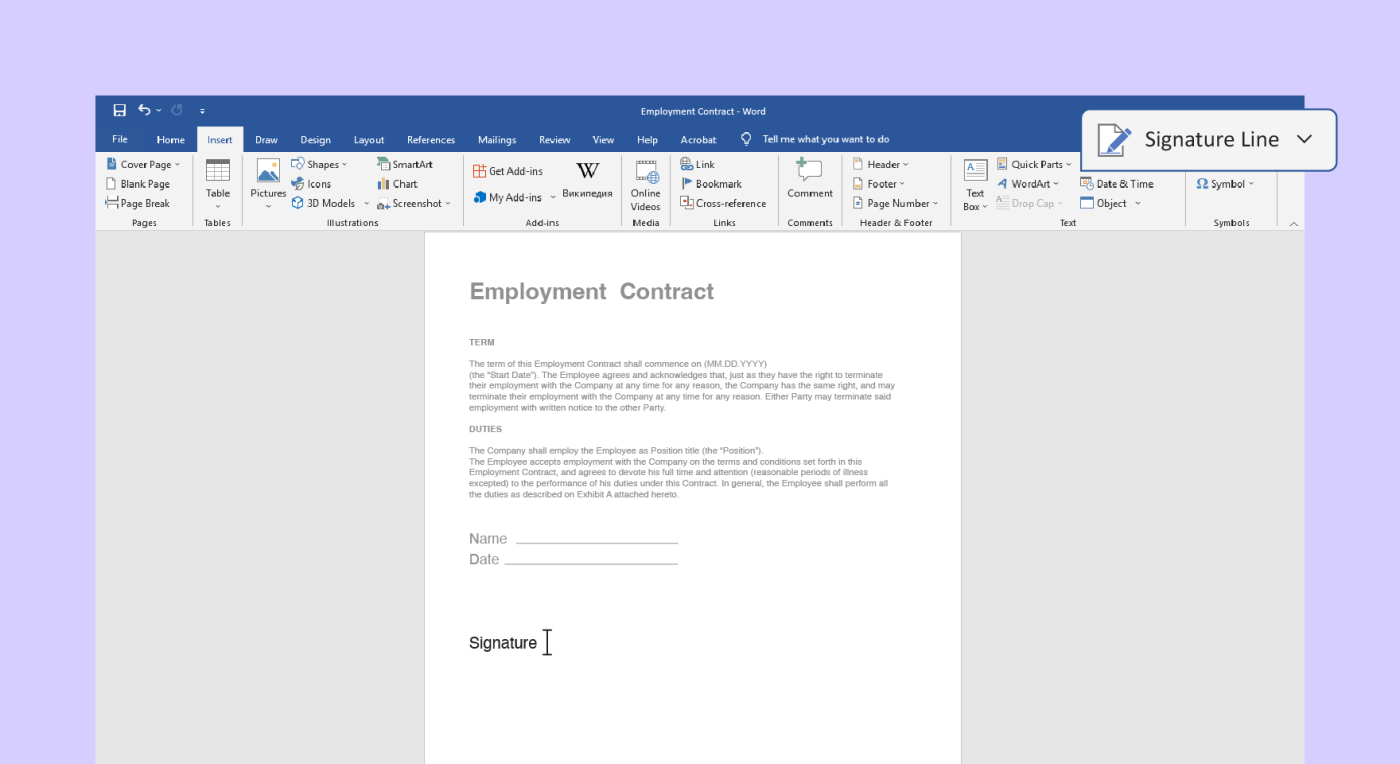
3. A dialogue box will pop up — fill in the required details (name of the signer, work title of the signer, and email ID of the signer).
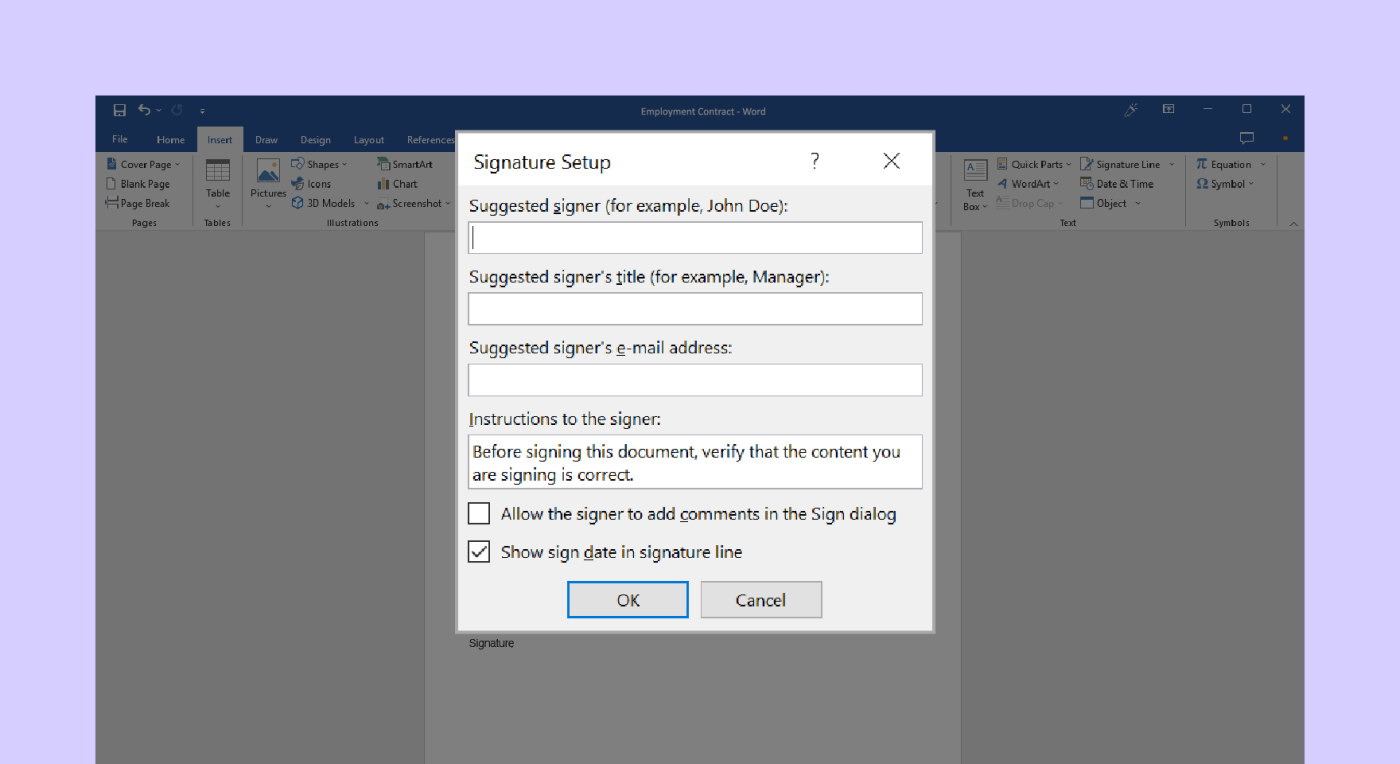
4. Mention the instructions you would like the recipient to read.
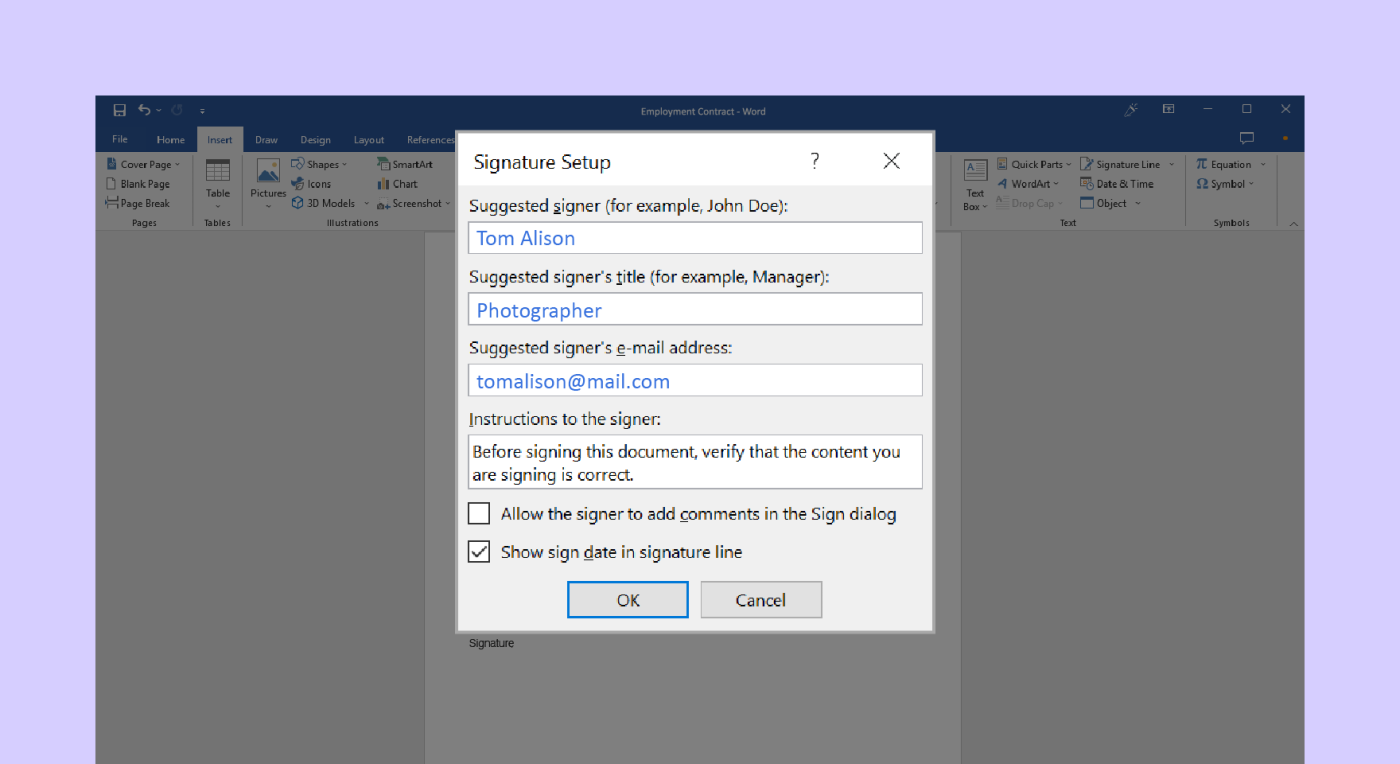
5. Allow the recipient to add comments (if you’d like), and select “show sign date.”
6. Click “OK.”
Why switch from using Word for electronic signatures?
Microsoft Word is not designed to be used as digital signature software, and while it can be used to create an electronic signature there are some gaps in functionality that limit its potential benefits.
If you are searching for how to create electronic signatures with ease, this is not the best option.
The biggest limitation of using Word is that it is not comprehensive in nature. Imagine your client sends you a PDF document or a ppt file. You can’t use Microsoft Word to sign those documents.
Apps like PandaDoc, that have an eSignature function, are compatible with multiple file types, including Word, ppt, pdf, xls, jpg, and more.
Another drawback is that you need to consider the client’s journey when they sign a document. Logically, these recipients need to read the document, decide if they’re interested, sign it themselves and then send it back.
As a business owner, your goal should be to make the signing process as easy as possible.
This can be done only when you have insights that tell you how and where did your recipient(s) interact with the documents you sent them. Unfortunately, this isn’t possible with Word.
Another big drawback of Word electronic signature software is that it is not the fastest way to eSign documents.
The thing is, anytime you want to sign a document on Word, you’d have to create a digital ID.
When you click on the X to sign, a dialog box would appear.
For some users, this dialog box redirects them to Microsoft support from where they can read the instructions to create a digital ID.
Whereas for others, you have to manually go to the Microsoft website to obtain a digital ID from one of Microsoft’s partners.
It’s important to note that the partners Microsoft mentions (GlobalSign and IdenTrust) require you to pay money to obtain a digital ID.
So, overall, Microsoft is not the most effortless software when it comes to eSigning.
How to do an electronic signature on platforms other than Microsoft Word
There are many other examples of software that are dedicated to creating, sending, and signing business documents digitally, such as PandaDoc and DocuSign.
PandaDoc and DocuSign have both been consistently ranking as the top-performing eSignature software.
While DocuSign has made a name for itself by launching first, PandaDoc has been giving it some serious competition with the help of its product offerings (unlimited audit trail, 24/7 support, dynamic pricing, and more).
The comparisons are numerous, and very much worth evaluating for yourself. If you’re still interested in exploring further, you can compare both softwares here.
The point that remains is that both these softwares provide services that offer a much broader range of useful features, generally making it straightforward to create signature fields and eSignatures.
PandaDoc, for example, provides users with a vast database of templates tailored to a wide range of business use cases that can easily be signed at the click of a button, as well as different types of quotes, proposals, or legal documents, that can be quickly uploaded to keep all information in one place.
Overall, this speeds up the creation of high-quality, professional documents.
Adding an eSignature is painless on these dedicated platforms, with intuitive interfaces and one-click addition often supported.
Once signed, documents can be sent to a list of recipients quickly and easily, directly through the software itself, and a secure signing certificate may be created as soon as the recipient signs the document.
Once sent, documents can then be tracked.
Viewer metrics like time spent on each page, how often the recipient viewed the document, the number of views, comments, and eSignatures on the document, and other similar data are gathered and presented to the sender automatically.
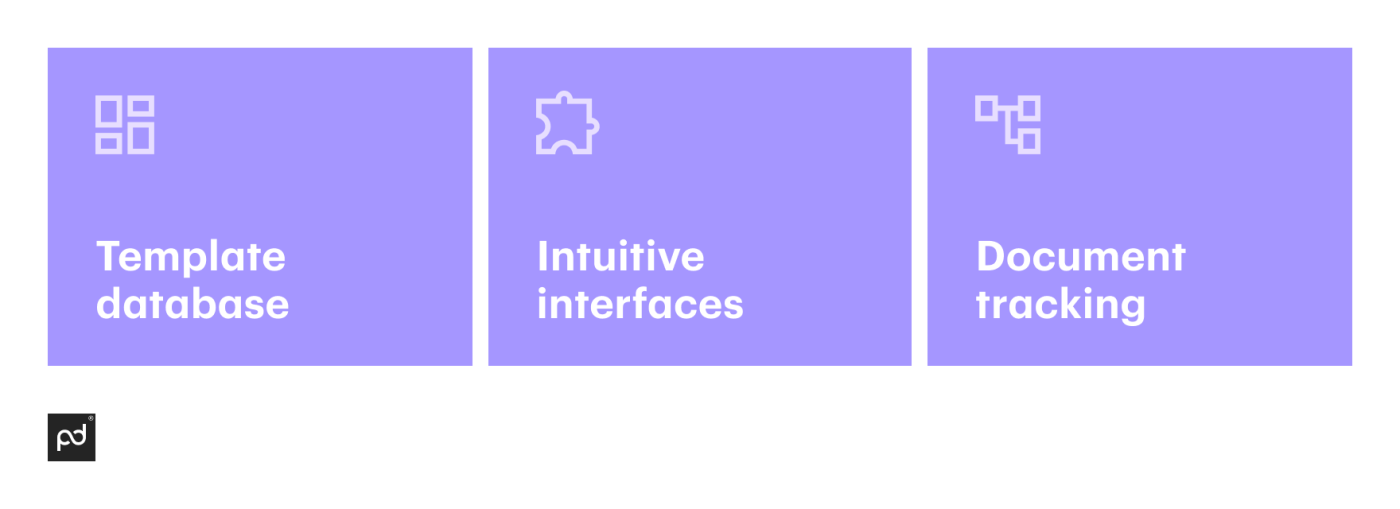
This information provides a microscopic view of what works and what doesn’t, allowing companies to fine-tune their sales documents and improve their effectiveness over time.
These powerful features mean that adopting a specialised eSignature and sales document platform can revolutionise the way you eSign. It also means that you can dramatically streamline your entire sales process.
Learn how to create an electronic signature in Word using PandaDoc integrated software
It could be that you’re a Word loyalist, or maybe you’re just not looking to fully switch to a new software (after all, who doesn’t love comfort?).
But there is one thing that we guarantee you’ll love more: a smoother eSigning process.
And for the very same reason, PandaDoc has integrated with Word, making limitations of digital signatures a problem of the past. You can now have the best of both worlds.
With this integration, you can send your document quickly to a list of prospects and/or internal team members (PandaDoc will open in a separate tab to not disturb your workflow).
You can also see if your recipient received your document with status updates letting you know whether they’ve signed or not.
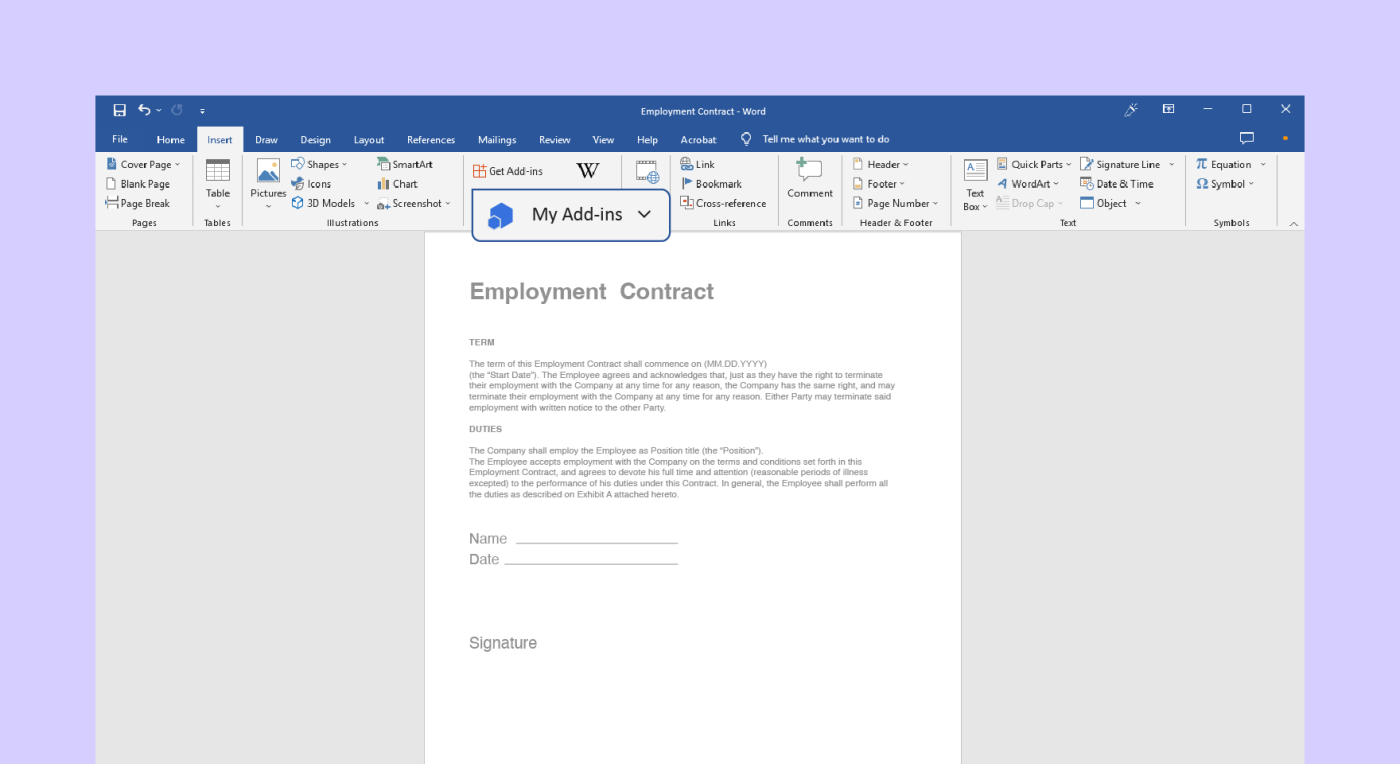
This integration makes it possible to sign existing Word documents, request eSignatures from multiple recipients, and check the status of your document — all at the click of a button.
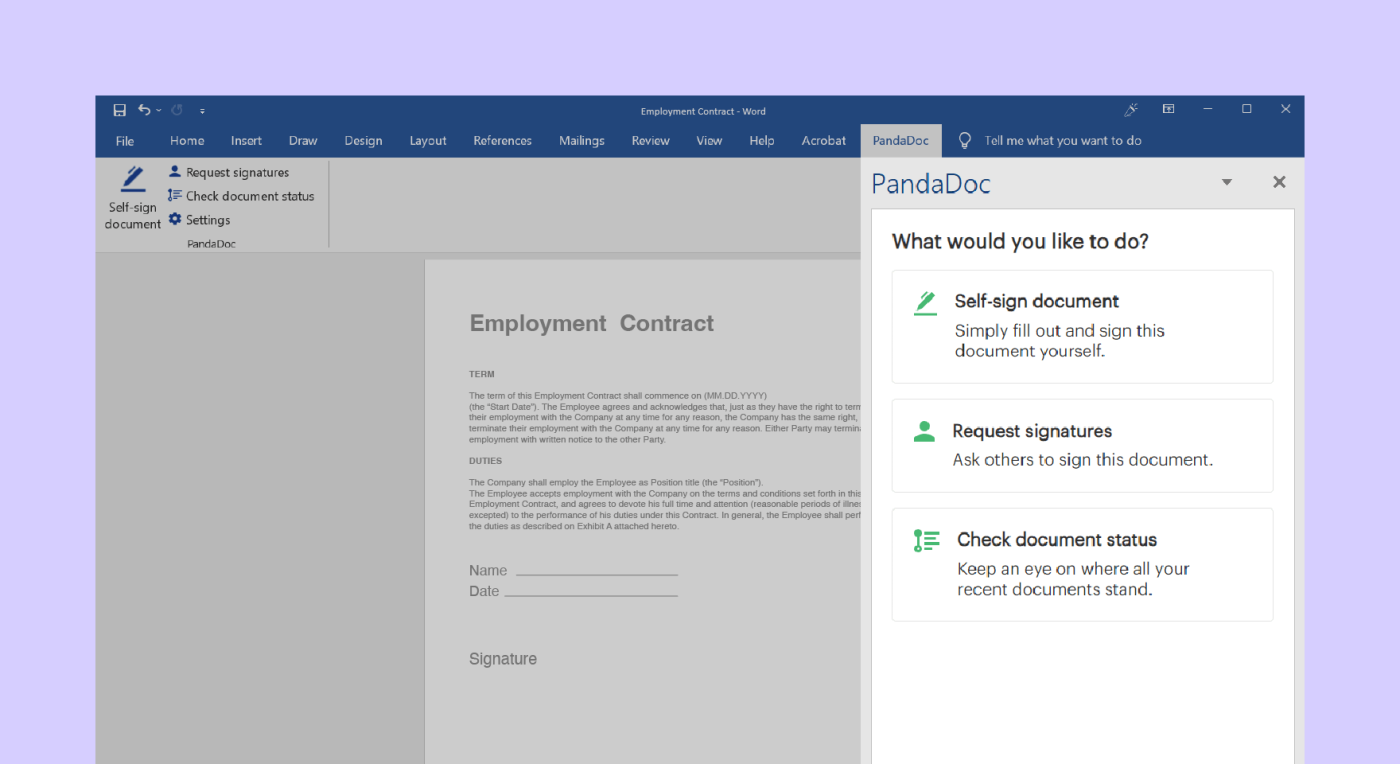
Even more, the integration is simple and uploads the documents directly to your PandaDoc account, making them easy to access from anywhere.
If interested, you can download the integration from Microsoft Marketplace.
How to add an eSignature to a Word document using PandaDoc
PandaDoc makes it a breeze to add electronic signatures to any document.
Just follow these steps:
1. Start a free trial account with PandaDoc and open your document (either by choosing a saved file from PandaDoc, or uploading a file from your computer or cloud storage app).
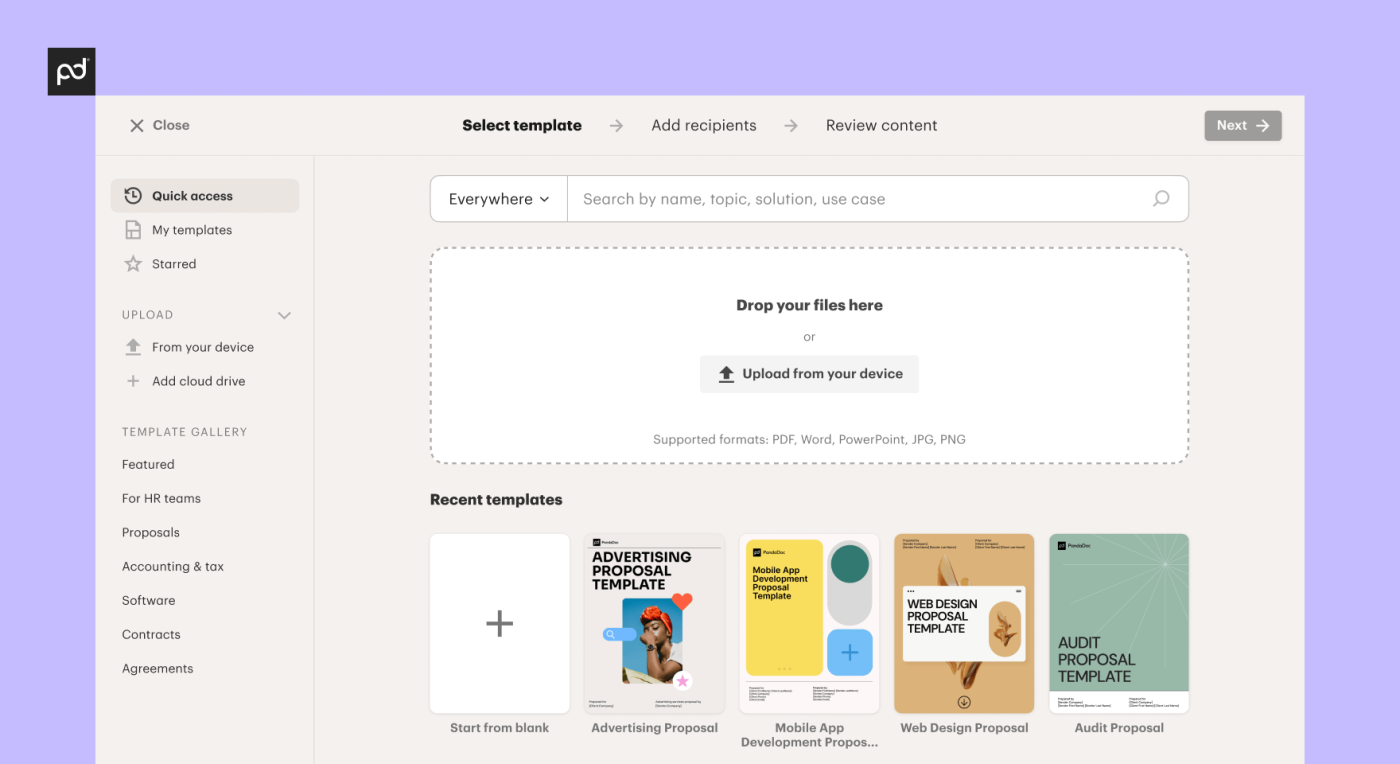
2. Drag and drop a signature field into the document and add any extra fields or text you want.
3. Choose your recipients and click send.
4. Recipients will get an email notification linking them directly to an online version of the document. They need to click the signature field and choose to draw, upload or type their electronic signature.
5. The sender’s copy of the document is automatically updated as signatures are added. Document activity can be tracked conveniently, and follow-ups are sent accordingly.
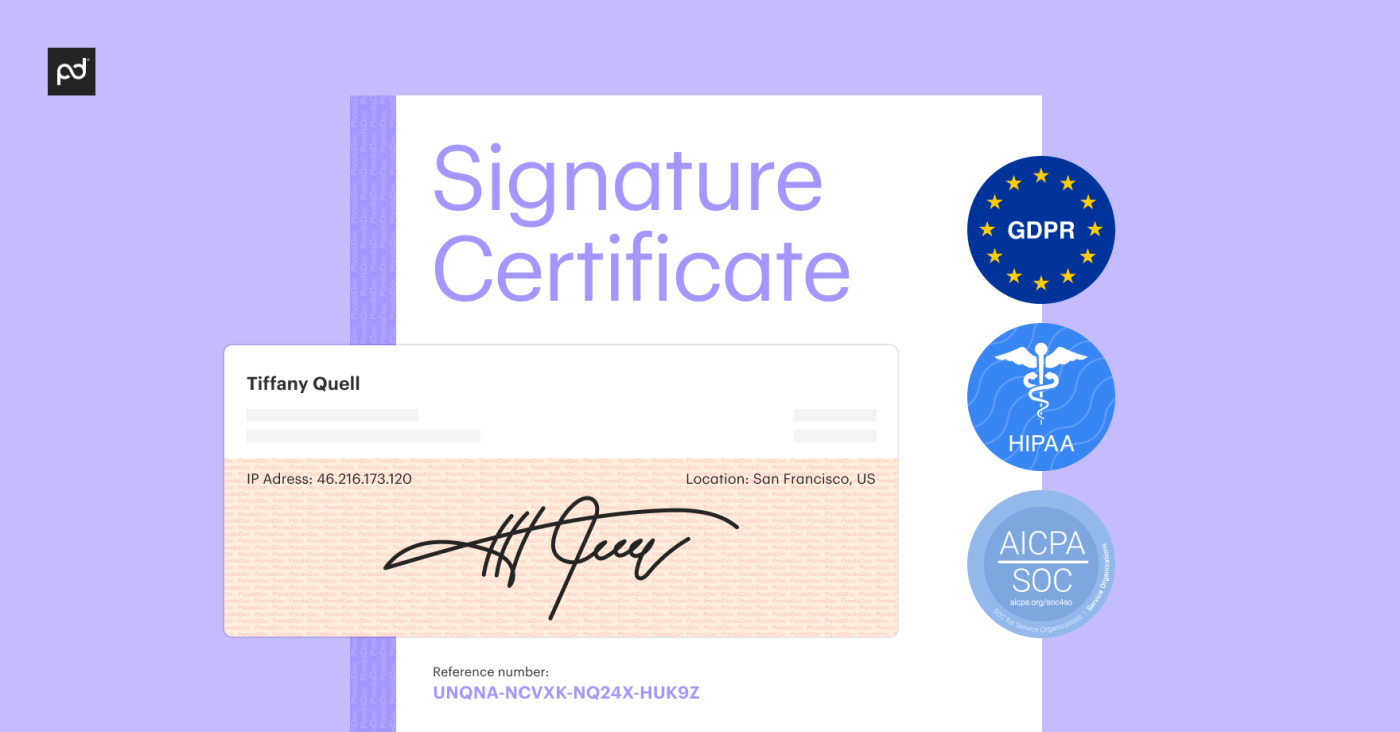
PandaDoc also creates a signature certificate that shows the signing date, IP address, location, and the time stamp ensuring the document’s legitimacy.
Discover a better alternative to Microsoft Word for eSigning your documents
Microsoft Word may be the most popular word processing software for both businesses and individuals, but that doesn’t always make it the best choice for electronic signatures.
There now exists a massive array of softwares dedicated to improving the document signing process.
Alternatives to Word such as PandaDoc not only make the eSigning process incredibly simple, but they also come with a wide range of other tools that can enhance your ability to create, send, sign and track a large number of important business documents with ease.
So, what’s stopping you from hopping on the PandaDoc train and creating an illustrious document signing experience?


